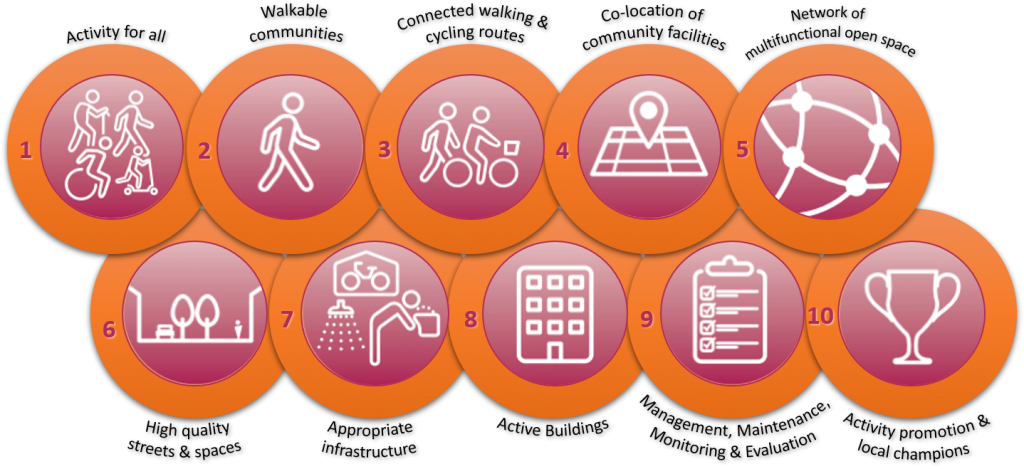Implementing Active Design Principles in the Built Environment Using BREEAM for Non-Domestic Buildings
BREEAM New Construction, In-Use and Refurbishment and Fitout are schemes for commercial and industrial assets they holistically address the environmental, social and economic impacts of a home


BREEAM UK New Construction is a certification standard used to assess new non-residential buildings, for example schools, community halls and sports venues.
Within the scheme structure there are 10 assessment categories covering a range of aspects to do with the asset such as the management, health and wellbeing of occupants, transport and the buildings wider effects on the natural environment.
How can BREEAM New Construction Contribute to Active Design?
Assessment Issues with a Strong Contribution
Management 01: Project Brief and Design
Credits are awarded for undertaking an integrated design process and robust stakeholder engagement from early in the project.
Aligns with all of the Active Design Principles.
Health and Wellbeing 07: Safe and Healthy Surroundings
Credits are awarded for dedicated walking and cycle ways which are easily accessible and connected to one and other.
Aligns with Active Design Principles 2 & 3.
Transport 02: Sustainable Transport Measures
Credits are awarded for implementing sustainable transport measures and connections to public transport.
Aligns with Active Design Principle 2.
Pollution 02: Local Air Quality
Recognises heating and hot water systems that have low or no impact on local air quality. Poor air quality can cause significant health issues that restrict activity, particularly for those with health issues
Aligns with Active Design Principle 1.
Assessment Issues with a Moderate Contribution
Innovation 01
Credits recognise development where sustainability related benefits are not rewarded by standard BREEAM issues. This could include any initiatives that are innovative in encouraging activity through design.
Aligns with all Active Design Principles.
Assessment Issues with a Minor Contribution
Transport 01: Transport Assessment and Travel Plan
This issue contributes to improving ecological value of the site, including provision of greenspace and habitat creation/enhancement.
Aligns with Active Design Principles 2, 3 & 4.
Land Use and Ecology 02: Identifying and Understanding the Ecological Risks and Opportunities
Recognises the ecological value of the site, including provision of greenspace and habitat creation/enhancement. ‘Wider site sustainability’ criteria also considers ways to achieve multiple sustainability and ecosystem services benefits.
Aligns with Active Design Principle 5.
Land Use and Ecology 03: Managing Negative impacts on Ecology
This issue recognises measures taken in the development of a project to protect the established biodiversity. biodiversity net gain which is contributed by ecological enhancement and creation.
Aligns with Active Design Principle 5.
Land use and Ecology 04: Change and Enhancement of Ecological Value
This issue recognises biodiversity net gain which is contributed by ecological enhancement and creation.
Aligns with Active Design Principle 5.
Land use and Ecology 05: Long Term Ecology Management and Maintenance
This issue recognises where ecological value is managed and maintained throughout the project and during occupation, which can contribute to good quality outdoor space that supports wildlife, for communities to enjoy.
Aligns with Active Design Principles 5 & 9.
Pollution 03: Flood and Surface Water Management
This issue recognises where ecological value is managed and maintained throughout the project and during occupation, which can contribute to good quality outdoor space that supports wildlife, for communities to enjoy.
Aligns with Active Design Principle 5.

BREEAM In Use international is a certification standard used to assess non- residential buildings which are currently in use and have been occupied for 3 years or more. For example schools, offices or sports venues.
Within the scheme structure there are 9 assessment categories covering a range of aspects to do with the asset such as the management, health and wellbeing of occupants and transport links to and from the building
How can BREEAM In-Use Contribute to Active Design?
Assessment Issues with a Strong Contribution
Transport 01: Cyclist facilities
Credits are awarded if the asset has changing facilities, bike shelters etc. , this infrastructure encourages occupants of the building to use active forms of travel.
Aligns with Active Design Principles 7 & 8.
Transport 02: Proximity to Public Transport.
Credits are awarded where there are public transport links within walking distance of the asset.
Aligns with Active Design Principle 2.
Transport 03: Proximity of Amenities
Credits are awarded where there are essential amenities within walking distance of the asset, e.g. bank, supermarket etc.
Aligns with Active Design Principle 4.
Transport 04: Pedestrian and Cyclist safety
Credits are awarded where there are dedicated, safe walking and cycling paths to and from the asset.
Aligns with Active Design Principle 6.
Assessment Issues with a Moderate Contribution
Health and Wellbeing 07: Indoor and Outdoor space
Credits are awarded for the provision of an outdoor space adjacent to buildings for all building users to benefit from.
Aligns with Active Design Principle 8.
Health and Wellbeing 10: Inclusive Design
Credits are given where there is inclusive design in infrastructre, creating a place which increases the accessibility for current and future users.
Aligns with Active Design Principle 1.
Health and Wellbeing 29: Communal Rest Areas
Credits are awarded for the provision of communal resting spaces which can encourage circulation, reduce sedentary behaviour and support occupiers mental wellbeing.
Aligns with Active Design Principles 7 & 8.
Transport 06: Transport Management Arrangements
Credits are awarded for the provision of walking routes and networks which minimise car based travel.
Aligns with Active Design Principles 2, 3 & 9.
Assessment Issues with a Minor Contribution
Materials 06: Future Adaptation
Credits are awarded for considering future adaption in the design of an asset which supports the long-term desired functionality of all spaces.
Aligns with Active Design Principle 9.
Materials 07: Designing for Robustness
Credits are awarded when the importance of protecting the infrastructure and landscape of an asset to minimise building part replacement.
Aligns with Active Design Principle 6 & 9.
Land Use and Ecology 01: Planted footprint
Credits are awarded for the availability of planted space within an asset, increasing occupants proximity to green infrastructure and features of ecological value.
Aligns with Active Design Principle 5.
Pollution 03: Impact Mitigation
Credits are awarded for the inclusion of areas which act as natural drainage systems such as sport fields and parks
Aligns with Active Design Principle 5.
Management 13: Building Adaptation
Credits are awarded where the future adaptations of the asset have been considered minimising the future maintenance and management needs.
Aligns with Active Design Principle 9.
Land Use and Ecology 05: External Landscaping and Maintenance
Credits are awarded for recognising the maintenance and management of open spaces making them more attractive to users.
Aligns with Active Design Principle 9.

BREEAM Refurbishment and Fit out is a certification standard used to assess non- residential buildings which are being refurbished, extended or re-purposed.
Within the scheme structure there are 10 assessment categories covering a range of aspects to do with the asset such as the management, health and wellbeing of occupants and transport links to and from the building.
How can BREEAM Refurbishment and Fit-Out Contribute to Active Design?
Assessment Issues with a Strong Contribution
Management 01: Project Brief and Design
Credits are awarded when integrated design processes and robust stakeholder engagement has been applied from early in the project which optimises the opportunities for implementing Active Design
Aligns with all Active Design Principles.
Transport 01: Sustainable Transport Solutions
Credits are awarded when sustainable transport solutions are intergrated into the devlopment including the use of walking and cycling routes which are complementary to public transport with the initial stages of all journeys being on foot or by bicycle.
Aligns with Active Design Principle 2, 3, 7 & 8.
Transport 02: Proximity to amenities
Credits are awarded where there are co-location of amenities in walking distance of each other support linked trips and in doing so can provide key active travel destinations.
Aligns with Active Design Principles 4 & 7.
Transport 03: Cyclist Facilities
Credits are awarded where active travel can be supported by providing appropriate and secure cycle parking, lockers, showers and changing rooms.
Aligns with Active Design Principles 7 & 8.
Transport 04: Maximum Car Parking Capacity
Credits are given for a reduction of maximum car parking capacity on streets and in sturctures to provide a way to increase the quality of those places. Furthermore the convenience of car can also affect the relative attraction of walking and cycling.
Aligns with Active Design Principle 3.
Assessment Issues with a Moderate Contribution
Innovation 01
Innovation credits recognise development where sustainability related benefits are not rewarded by standard BREEAM issues. This could include any initiatives that are innovative in encouraging activity through design.
Aligns with all Active Design Principles.
Assessment Issues with a Minor Contribution
Transport 05: Travel plan
Credits are given when measures have been developed into the travel plan which increase or improve more sustainable modes of transport, such as walking can support the delivery of walkable communities.
Aligns with Active Design Principle 2.
Materials 05: Designing for durability and resilience
Credits are awarded for the use of durable materials and design strategies can contibute to the long-term high quality feel of the external fabric of the building and the lanscaping of the surrounding external areas. In doing so it can promote activity over the long term.
Aligns with Active Design Principle 6.
Land use and ecology 02: Protection of ecological features
Credits are awarded when the protection of ecological features can provide a point of attractiveness and interest which can encourage use of open space for activity.
Aligns with Active Design Principle 5.
Land use and ecology 04: Enhancing site ecology
Credits are given for enhancing a sites ecological features which can provide additional points of attractiveness and interest which can encourage use of open space for activity.
Aligns with Active Design Principle 5.
Land use and ecology 05: Long term impact on biodiversity
Credits are awarded when ecological value is managed and maintained throughout the project and during occupation, which can contribute to good quality outdoor space that supports wildlife, for communities to enjoy.
Aligns with Active Design Principle 5.


